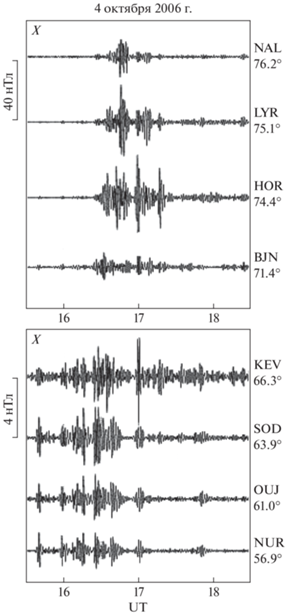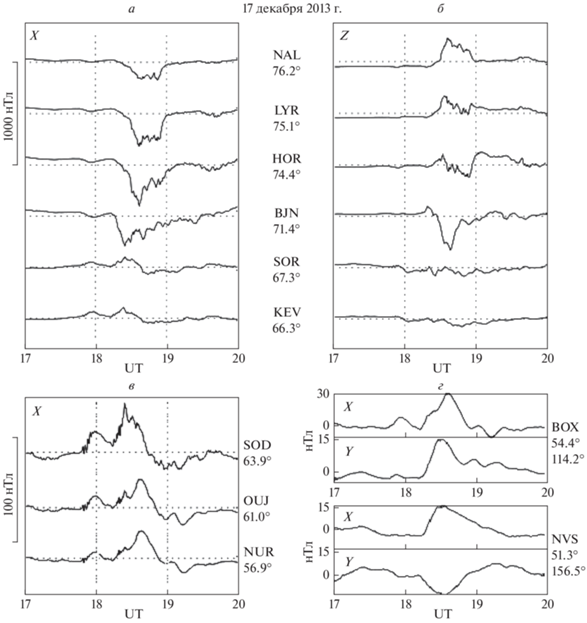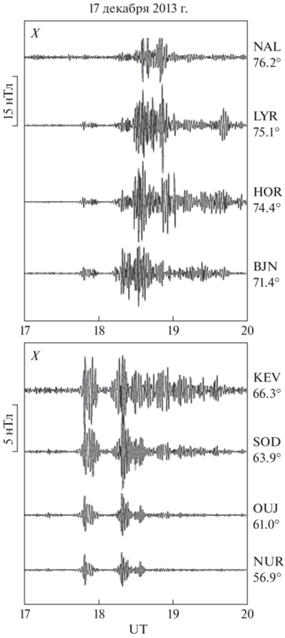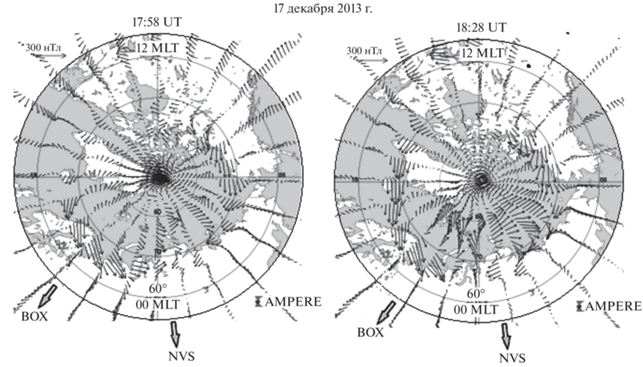Геомагнетизм и аэрономия, 2023, T. 63, № 3, стр. 327-339
Особенности полярных суббурь: анализ отдельных событий
Н. Г. Клейменова 1, *, Л. И. Громова 2, **, И. В. Дэспирак 3, Л. М. Малышева 1, С. В. Громов 2, А. А. Любчич 3
1 Институт физики Земли РАН (ИФЗ РАН)
Москва, Россия
2 Институт земного магнетизма, ионосферы и распространения радиоволн
им. Н.В. Пушкова РАН (ИЗМИРАН)
Москва, Троицк, Россия
3 Полярный геофизический институт
Апатиты, Мурманская обл., Россия
* E-mail: ngk1935@yandex.ru
** E-mail: gromova@izmiran.ru
Поступила в редакцию 12.01.2023
После доработки 18.01.2023
Принята к публикации 26.01.2023
- EDN: PMHUMI
- DOI: 10.31857/S0016794023600023
Аннотация
К полярным суббурям относятся суббури, наблюдаемые на геомагнитных широтах выше 70° MLAT при отсутствии одновременных отрицательных магнитных бухт на более низких широтах, т.е. суббури на сжатом авроральном овале. На примере отдельных событий, зарегистрированных на арх. Шпицберген, рассмотрены общие морфологические особенности полярных суббурь. Показано, что полярные суббури, как и “классические” суббури, характеризуются формированием токового клина суббури, скачкообразным перемещением к полюсу после начала суббури; генерацией геомагнитных пульсаций Pi2, возрастанием РС-индекса полярной шапки перед началом суббури. В то же время имеются определенные отличия полярных суббурь от “классических” суббурь, а именно, начало на более удаленных L-оболочках, развитие в области сжатого аврорального овала, появления в более ранние предполуночные часы, генерация только при низкой скорости солнечного ветра и в слабо возмущенных геомагнитных условиях. Высказано предположение, что полярные суббури, по-видимому, представляют собой специфический тип “классических” суббурь, развивающихся в вечернем секторе при магнито-спокойных или слабо возмущенных условиях, когда авроральный овал сжат. Источником полярных суббурь может быть также локальная интенсификация существующих ранее суббурь в послеполуночном секторе.
1. ВВЕДЕНИЕ
Магнитосферные суббури являются важным элементом космической погоды, поэтому они интенсивно исследуются в последние 50 лет. Энергия, поступающая из солнечного ветра, в подготовительную фазу суббури (growth phase) накапливается в магнитосфере и ее хвосте, а затем в фазу развития суббури (expansion phase), называемой также “активной фазой”, взрывообразно высвобождается. При этом в магнитосфере усиливаются продольные токи и вызываемые ими ионосферные токи, наблюдаемые на земной поверхности в виде бухтообразных возмущений геомагнитного поля, вспыхивают полярные сияния, происходит генерация геомагнитных пульсаций и ОНЧ-излучений, усиливается высыпание энергичных частиц в ионосферу и т.д.
Концепция магнитосферной суббури была предложена в работе [Akasofu et al., 1964] как комплекс явлений и процессов, охватывающих почти всю магнитосферу. В дальнейшем будем называть такие суббури “классическими”. Исследованию различных геофизических проявлений суббури и их физике посвящены сотни публикаций, однако пока еще нет окончательного ответа на вопрос, что же является источником суббури, и где он расположен. Магнитосферная суббуря – типичное ночное возмущение в области аврорального овала [Фельдштейн, 1963], т.е. в области развития дискретных форм сияний, которая в зависимости от магнитной активности может находиться на геомагнитных широтах от ~60 до ~75° MLAT и выше. С уменьшением геомагнитной активности овал сжимается и сдвигается к полюсу [Feldstein and Starkov, 1967]. К настоящему времени надежно установлено, что суббуря начинается с внезапного уярчения спокойной дуги вблизи экваториальной границы овала. В зависимости от положения этой границы авроральный овал считается “нормальным”, если эта граница расположена в интервале 65°–66° MLAТ, “расширенным” (expanded), если граница находится ниже 65° MLAT, и “сжатым” (contracted), если выше 66° MLAT [Lui et al., 1973].
Полярная граница аврорального овала совпадает с границей замкнутой магнитосферы, т.е. c ионосферной проекцией границы открытых и замкнутых силовых линий (open/closed field line boundary – OCB), которая является границей полярной шапки (polar cap boundary – PCB). На спутнике DMSP полярная граница аврорального овала определялась как граница высыпаний частиц b5i и b5e [Newell et al., 1996]. В работе [Clausen et al., 2012] показано, что широта положения максимума интенсивности высокоширотных продольных токов зоны R1 [Iijima and Potemra, 1978] находится примерно на 1° экваториальнее границы полярной шапки, а низкоширотная зона продольных токов R2 локализована вблизи экваториальной границы овала. В работе [Clausen et al., 2012] положение максимумов интенсивности продольных токов R1 и R2, определялись по магнитным наблюдениям на высотах ионосферы (~780 км) в проекте AMPERE (Active Magnetosphere and Planetary Electrodynamics Response Experiment), включающему одновременную регистрацию на 66 спутниках связи.
В магнито-возмущенные периоды при большой скорости солнечного ветра суббури могут распространяться до очень высоких широт и наблюдаться на земной поверхности почти до геомагнитного полюса, например, [Сергеев и др., 1979; Loomer and Gupta, 1980; Nielsen et al., 1988; Mende et al. 1999; Дэспирак и др., 2008]. При этом, чем выше скорость солнечного ветра, тем больше широта, до которой распространяется суббуря [Дмитриева и Сергеев, 1984]. Это так называемые “расширенные” суббури [Дэспирак и др., 2008; Despirak et al., 2018] или “суббури на расширенном овале”.
В то же время было установлено, что на таких высоких широтах суббури могут наблюдаться и в магнито-спокойное время, когда авроральный овал сжат и его экваториальная граница отмечается на геомагнитных широтах выше 66° MLAT. Эти суббури были названы “суббурями на сжатом овале” [Akasofu et al., 1973; Lui et al., 1976; Milan et al., 2008], позднее такие суббури стали называть “полярными суббурями” [Клейменова и др., 2012; Дэспирак и др. 2014, 2022; Сафаргалеев и др., 2018; Safargaleev et al., 2020], так как они наблюдаются вблизи полярной границы овала. Исследования этих суббурь как специфического вида классических суббурь явно недостаточны и, по существу, только начинаются.
Было установлено [Клейменова и др., 2012], что полярные суббури наблюдаются в предполуночные часы (20–22 MLT) при слабой геомагнитной активности (Kр ∼ 2), наиболее часто в позднюю восстановительную фазу магнитной бури и сопровождаются интенсивными геомагнитными пульсациями диапазона Pi2 и Pi3, более чем на порядок превышающих типичную амплитуду этих пульсаций в авроральных широтах. При благоприятных метеоусловиях во время полярных суббурь регистрируются полярные сияния в виде вытянутых вдоль овала дуг, иногда с необычными спиральными структурами. Во время взрывной фазы суббури дуги быстро перемещаются к полюсу, что подтверждено в работах [Safargaleev et al., 2020; Дэспирак и др., 2022]. Было установлено [Дэспирак и др., 2014, 2019; Despirak et al., 2018], что полярные суббури регистрируются при низкой скорости солнечного ветра, наблюдаемой после прохождения высокоскоростного рекуррентного потока, или во время медленного потока солнечного ветра, а также в поздней восстановительной фазе геомагнитной бури.
Целью данной работы является продолжение исследований полярных суббурь для выявления их отличий (или подобия) от морфологических характеристик “классических” суббурь.
1. РЕЗУЛЬТАТЫ НАБЛЮДЕНИЙ
Данная работа основана на анализе наблюдений на скандинавском меридиане сети магнитометров IMAGE (http://space.fmi.fi/image/) с дискретизацией 10 с. Это единственная в мире плотная сеть станций, расположенных почти вдоль геомагнитного меридиана (~105°–110° MLON, c MLT = UT + 2.5 ч) от полярных широт архипелага Шпицберген до средних широт Белоруссии. Мы рассматривали данные наблюдений за зимние месяцы (ноябрь–февраль), когда проводится регистрация полярных сияний, 24-го цикла солнечной активности, с 2010 по 2021 год.
К полярным суббурям мы относили суббури, которые были зарегистрированы на Шпицбергене на геомагнитных широтах выше 70° MLAT при отсутствии отрицательных магнитных бухт на более низких широтах, т.е. на материковых станциях. На рисунке 1а показана географическая карта Скандинавии с указанием станций IMAGE, используемых в данной работе. На карте видно, что промежуточной станцией между архипелагом Шпицберген и материком является станция Bear Island (BJN, 71.4° MLAT) на острове Медвежий, южнее которого расположено море, на берегу которого находится первая континентальная станция Soeroeya (SOR, 67.8° MLAT). Если магнитные бухты наблюдались в BJN, но отсутствовали в SOR, то условной низкоширотной границей появления магнитных бухт можно считать середину расстояния между пунктами BJN и NOR, т.е. порядка 70° MLAT, поэтому эта широта и использовалась как граничная в развитии полярных суббурь. Это соответствует условиям сжатого овала [Lui et al., 1973]. На рис. 1б приведено типичное положение аврорального овала во время развития полярной суббури, которая будет подробно рассмотрена ниже.
Рис. 1.
Географическая карта используемых станций профиля IMAGE (а) и положение аврорального овала 4 октября 2006 г. (б).
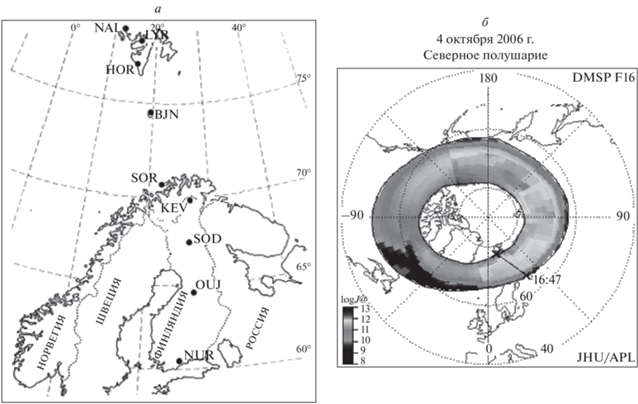
Для дальнейшего анализа было выбрано 290 случаев полярных суббурь, зарегистрированных на Шпицбергене. Анализ суточного хода их появления показал, что подавляющее большинство (82%) событий наблюдалось до геомагнитной полночи.
2.1. Суточный ход времени начала полярных суббурь
Важной характеристикой суббури является время и место ее резкого начала (onset), эти исследования важны для решения вопроса о природе и механизме начала суббури [Frey et al., 2004]. На земной поверхности начало суббури определяется по времени внезапного резкого падения Х-компоненты магнитного поля на самой низкоширотной станции появления суббури. В исследуемых событиях, как правило, это была станция BJN.
В работе [Milan et al., 2010] были исследованы данные о местном магнитном времени (MLT) начал (onset) около 2000 изолированных суббурь, зарегистрированных на спутнике IMAGE [Mende et al., 2000] в 2000–2002 гг. [Frey et al., 2004]. На рис. 2 представлены полученные в работе [Milan et al., 2010] результаты. В этой работе суббури выбирались по очень строгим критериям: исследовались только изолированные суббури, начало которых сопровождалось локальным уярчением полярных сияний, быстро перемещающихся затем к полюсу и к западу, в вечерний сектор. На среднем графике рис. 2 показано полученное в работе [Milan et al., 2010] облако точек начал суббурь относительно MLT и геомагнитной широты, а на верхнем и правом графиках это же распределение по числу случаев (n). На верхний график мы нанесли жирными точками полученное нами распределение начал полярных суббурь на Шпицбергене (цифры на правой шкале).
Рис. 2.
Суточный ход начал суббурь из работы [Milan et al., 2010]. Жирными точками показан полученный нами суточный ход начал полярных суббурь, зарегистрированных на арх. Шпицберген.
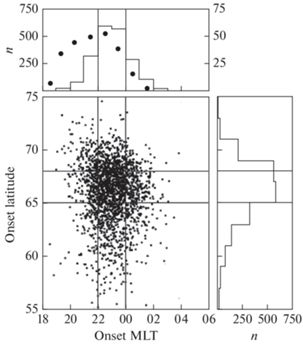
Из рис. 2 видно, что большинство суббурь, которое можно отнести к “классическим” суббурям начинается на геомагнитных широтах 65°–67° MLAT (т.е. на “нормальном” овале по [Lui et al., 1973] перед полуночью (в 22–24 MLT). Большая часть исследуемых нами суббурь начиналась вблизи BJN, т.е. на более высоких геомагнитных широтах, порядка 70° MLAT, в интервале 20–23 MLT. В общих чертах это согласуется с графиком [Milan et al., 2010] положения начал суббурь на таких широтах (верхний левый угол облака распределений на рис. 2). Таким образом, в отличие от “классических” суббурь, начало полярных суббурь наблюдается в вечернем секторе и на более высоких широтах.
2.2. Полярная суббуря 4 октября 2006 г.
Для детального анализа отдельных событий была выбрана полярная суббуря, зарегистрированная на Шпицбергене 4 октября 2006 года в 16:30–17:30 UT, так как за это время в своих архивах мы нашли положение аврорального овала в географических координатах (рис. 1б), определенное по программе OVATION, которая к настоящему времени закрыта. Особенностью этого события было то, что в этот интервал времени положение овала было определено по данным наблюдений высыпания частиц на спутнике DMSP F16, пролетающим над Шпицбергеном. Положение аврорального овала в других секторах местного времени были построены по модельным расчетам. К сожалению, сайт спутников DMSP не дает результатов регистрации на пролетах позже 15 UT (интересующий нас пролет был в 16:47 UT).
На рис. 3а, 3б представлены магнитограммы высокоширотных станций IMAGE. Видно, что полярная суббуря началась около 16.30 UT между станциями BJN и HOR. Сопоставляя это с положением аврорального овала (рис. 1б), можно прийти к выводу, что в отличие от “классических” суббурь, начинающихся вблизи экваториальной границы овала, данная полярная суббуря началась и развивалась в более высоких широтах, ближе к приполюсной границе овала. Такоe же развитие полярной суббури отмечалось и в работе [Safargaleev et al., 2020].
Рис. 3.
Магнитограммы высокоширотных (а, б) и субавроральнях (в) станций профиля IMAGE для события полярной суббури 4 октября 2006; (г) магнитограммы низкоширотных станций Борок (BOX) и Новосибирск (NVS).
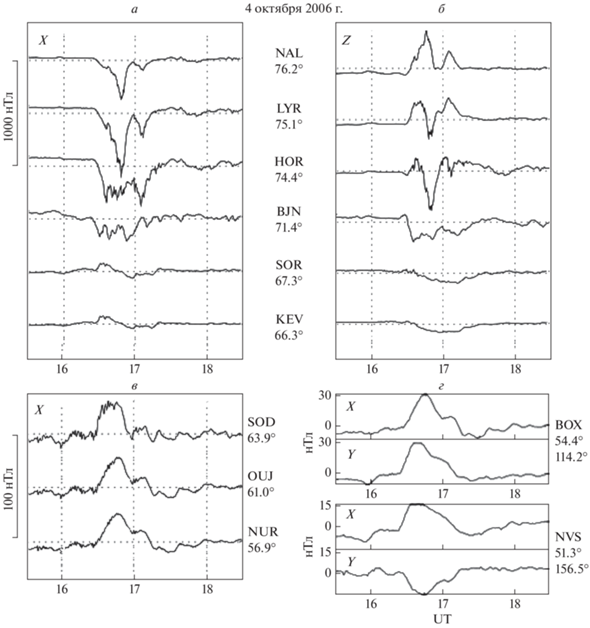
Метеоусловия на Шпицбергене в этот день не позволили провести наблюдения полярных сияний. Заметим, что в окрестностях BJN нет камер полного неба для регистрации сияний (all-sky camera – ASC). Ближайшая континентальная станция, где проводятся такие наблюдения, Абиско (АВК) находится южнее BJN примерно на 800 км. Обычно, если начало полярной суббури регистрировалось вблизи BJN, то в условиях хорошей погоды в самом верхнем углу обзора ASC камеры в ABK можно было увидеть появление свечения, соответствующее брейкапу сияний в BJN.
Рисунок 3в показывает, что обсуждаемая полярная суббуря, как и “классическая” суббуря, сопровождалась развитием положительной магнитной бухты в более низких широтах. Это свидетельствует о формировании токового клина суббури (substorm current wedge – SCW) [McPherron et al., 1973; Sergeev, 1974; Horning et al., 1974] с центром на меридиане начала суббури, т.е. развитие трехмерной токовой системы, механизмы генерации которой подробно рассмотрены, например, в обзорной работе [Kepko et al., 2015]. Долготные размеры области ионосферной проекции SCW могут быть определены по знаку Y-компоненты магнитного поля на среднеширотных станциях. На рисунке 3г показаны магнитограммы среднеширотных станций Борок (BOX, 54.4° MLAT, 114° MLON), расположенной вблизи меридиана сети IMAGE, и станции Новосибирск (NVS, 51.3° MLAT, 156° MLON). Видно, что знак вариаций Y-компоненты поля на этих станциях имел противоположное направление. Следовательно, центр токового клина суббури, т.е. область начала (onset) рассматриваемой полярной суббури, находился между этими станциями, восточнее Скандинавского меридиана IMAGE.
Небольшие положительные отклонения поля видны на магнитограммах субавроральных и среднеширотных станций и перед началом суббури, что согласно работе [Troshichev et al., 1974] может быть результатом усиления восточного электроджета в вечернем секторе за счет возрастания магнитосферной конвекции в подготовительную фазу суббури.
Рассмотрим особенности типичных для начала суббури геомагнитных пульсаций диапазона Pi2 (периоды 40–150 с), характеристики которых обсуждались во многих статьях и обзорах, например, [Saito, 1969; Troitskaya and Kleimenova, 1972; Пудовкин и др., 1976; Pashin et al., 1982; Olson, 1999; Keiling and Тakahasi, 2011]. На рис. 4 приведена Х-компонента геомагнитных пульсации диапазона Pi2 во время этой суббури, полученных в результате фильтрации 10-с магнитограмм в полосе частот 7–20 мГц. На верхнем графике рис. 4 показаны пульсации на более высокоширотных станциях профиля IMAGE, а на нижнем графике – на более низкоширотных станциях (геомагнитная широта каждой станции приведена справа от магнитограммы, под кодом станции). Масштаб верхних и нижних графиков отличается в 10 раз. Видно, что, как и в случае “классических” суббурь, начало полярной суббури и каждая ее активизация сопровождались в высоких широтах всплеском геомагнитных пульсаций Pi2, амплитуда которых доходила до 40–50 нТл, т.е. была на порядок выше типичных амплитуд Pi2-пульсаций. Такая особенность высокоширотных Pi2-пульсаций во время полярных суббурь ранее отмечалась в работе [Клейменова и др., 2012]. Начало всплеска Pi2 перемещалась со временем в сторону полюса, синхронно с началом полярной суббури, что типично и для “классической” суббури.
Как следует из магнитограмм на рис. 3, в 17:00 UT в HOR началась новая, более слабая суббуря с максимумом интенсивности в HOR. В геомагнитных пульсациях (рис. 4) начало этой суббури проявилось в виде короткого, но очень интенсивного всплеска Pi2, когерентного на всех широтах (наиболее четко видно на более низкоширотных станциях), что типично для “классической” суббури.
Отдельные когерентные всплески Pi2-пульсаций в субавроральных широтах с амплитудой до 3 нТл наблюдались и перед полярной суббурей (нижний график на рис. 4), в ее подготовительную фазу, что также типично для “классической” суббури, например, [Зверев и др., 1969]. Эти пульсации практически не видны на верхнем графике из-за относительно грубого вертикального масштаба.
Таким образом, поведение геомагнитных пульсаций Pi2 во время развития полярной суббури такое же, как и в случае “классической” суббури, но в отличие от “классической” суббури амплитуда высокоширотных Pi2-пульсаций во время полярной суббури почти на порядок выше.
2.3. Полярная суббуря 17 декабря 2013 г.
Для примера рассмотрим еще один случай полярной суббури, зарегистрированной в более поздние годы (17 декабря 2013 г.), когда имелись данные наблюдений по проекту AMPERE [Anderson et al., 2002]. Как и в предыдущем случае, эта полярная суббуря наблюдалась в относительно магнито-спокойное время (Kр = 1–2). В нашей работе использовались общедоступные данные проекта AMPERE, представленные на сайте (https:// ampere.jhuapl.edu/browse/) в виде обобщенных за 10 мин карт распределения ионосферных токов, построенных по результатам сферического гармонического анализа магнитных измерений на 66 одновременно работающих ионосферных спутниках. По этим измерениям также вычисляются карты распределения втекающих и вытекающих в ионосферу продольных токов. В нашей работе карты продольных токов не приводятся, так как на них втекающие и вытекающие токи показаны синим и красным цветом, которые при переводе их в черно-белый вариант, к сожалению, становятся неразличимыми.
На рис. 5 приведены магнитограммы тех же станций IMAGE, что и на рис. 3 в таком же формате. Полярная суббуря началась около 18:20 UT между станциями BJN и SOR, ближе к BJN. Затем суббуря начала быстро перемещаться к полюсу. Максимум интенсивности суббури сначала отмечался в HOR, и ионосферный ток, судя по вариациям Z-компоненты поля, находился ниже HOR, но затем быстро переместился в более высокие широты. Интенсивность этой полярной суббури была почти вдвое меньше, чем полярной суббури 4 октября 2006 (рис. 3).
Как и в рассмотренном выше событии 4 октября 2006 г., в случае полярной суббури 17 декабря 2013 г. в субавроравльных и средних широтах наблюдалась положительная магнитная бухта, пик которой сначала был в SOD и совпадал с максимумом суббури в BJN. Интересно отметить, что величина положительного пика в SOD, соответствующего максимуму суббури в BJN, виден и на более низкоширотных станциях OUJ и NUR (рис. 5) с амплитудой, быстро уменьшающейся с широтой. Следующий пологий максимум субавроральной положительной бухты совпал с максимумом суббури в HOR четко виден на всех трех станциях (SOD, OUJ, NUR) с близкой амплитудой. Вариации Х- и Y-компонент поля в низкоширотных станциях BOX и NVS свидетельствуют о том, что центр токового клина этой полярной суббури, как и в предыдущем случае, находился восточнее меридиана IMAGE.
Как и в предыдущем событии, перед началом суббури на субавроральных и среднеширотных станциях наблюдались небольшие положительные отклонения в Х-компоненте поля (рис. 5), свидетельствующие об усилении восточного электроджета в вечернем секторе в подготовительную фазу суббури. Видно, что амплитуда этих отклонений уменьшалась с уменьшением широты. Такие вариации типичны для “классической” суббури, например, [Troshichev et al., 1974].
Геомагнитные пульсации Pi2, сопровождающие эту суббурю приведены на рис. 6. Общие закономерности динамики геомагнитных пульсаций были подобны событию 4 октября 2006. Однако на высокоширотных станциях амплитуда Pi2, как и возмущений магнитного поля 17 декабря 2013 г, была меньше, чем в событии 4 октября 2006 г. Это означает, что генерация пульсаций в высоких широтах как-то (пока еще не понятно каким образом) связана с интенсивностью ионосферного тока или с проводимостью ионосферы. Интересно отметить, что в низких широтах наблюдалась обратная закономерность. Амплитуда пульсаций Pi2 в KEV и SOD 17 декабря 2013 г. была значительно больше, чем в случае 4 октября 2006 г. (см. разницу в вертикальном масштабе на рис. 4 и 6). Пульсации Pi2 в подготовительную фазу суббури 17 декабря 2013 г. тоже были значительно интенсивнее. Пока не удается объяснить этот факт.
На рис. 7 приведены две карты AMPERE распределения ионосферных токов перед началом полярной суббури, т.е. в ее подготовительную фазу (около 18 UT) и во время начала этой суббури (в 18:25 UT). Видно, что перед данной суббурей в вечернем секторе наблюдался восточный электроджет, усиление которого отмечаются на субавроральных станциях IMAGE (рис. 5). В утреннем секторе (~02–09 MLT) отмечалось усиление западного электроджета, что на земной поверхности проявилось как развитие магнитной суббури, четко видимой в ~04 MLT на магнитограммах станции Тикси, 66.7° MLAT (эти данные здесь не приводятся).
Начало полярной суббури было связано с появлением вблизи Шпицбергена сильного вихря (правая карта на рис. 7), свидетельствующего об усилении продольных токов, что отмечалось и на цветных картах продольных токов AMPERE, которые здесь не приводятся. Вблизи локальной магнитной полуночи в этой области пространства находится граница между восточным (вечерним) и западным (послеполуночным) током (разрыв Харанга). В приполярных широтах вечернего сектора развился достаточно интенсивный западный ток, который на земной поверхности наблюдался как полярная суббуря на Шпицбергене. При этом над материковыми станциями виден восточный электроджет, а на более высоких широтах – западный электроджет.
Таким образом, анализируемая полярная суббуря не является отдельным независимым явлением, а представляет собой результат развития высокоширотного магнитного возмущения в вечернем секторе как локальной интенсификации существующей ранее суббури в послеполуночном секторе Земли.
2. ОБСУЖДЕНИЕ
Выше были представлены результаты детального исследования двух суббурь, зарегистрированных на арх. Шпицберген в условиях сжатого овала. В обоих случаях на меридиане IMAGE возмущения наблюдались только на высоких геомагнитных широтах (>70° MLAT) при отсутствии отрицательных магнитных бухт на более низких широтах, т.е. по определению [Клейменова и др., 2012] обе суббури могут быть отнесены к “полярным суббурям”.
Заметим, что в ряде ранних работ, например, [Hones et al., 1971, 1985] бухтообразные возмущения в приполярных широтах рассматривались как внезапное перемещение полярных сияний и западного электроджета в высокие широты (“poleward leap”), или оторваршиеся “облака” вытекающих продольных токов (“detached region”), [Iijima and Potemra, 1978]. Согласно работе [Pytte et al., 1978] “poleward leap” появляется в позднюю восстановительную фазу суббури и связан с вытягиванием силовых линий в хвосте магнитосферы. Морфологические характеристики “poleward leap” принципиально отличаются от характеристик высокоширотной экспансии магнитосферных суббурь [Pytte et al., 1978], прежде всего, отсутствием геомагнитных пульсаций Pi2, которые являются характерным признаком развития суббури [Saito et al., 1976] и ее активизаций, а также отсутствием формирования токового клина, т.е. отсутствием положительных магнитных бухт на субавроральных и средних широтах. Следовательно, рассмотренные в нашей работе полярные суббури не могут быть отнесены к категории возмущений типа “poleward leap”.
Обе рассмотренные суббури наблюдались при спокойной космической погоде, в предшествующие дни не было существенных возмущений. В таких условиях экваториальная граница аврорального овала перемещается в сторону высоких широт, т.е. овал становится поджатым к полярной шапке. На рис. 8 приведены вариации параметров межпланетного магнитного поля (ММП) и солнечного ветра (скорость и динамическое давление) по 1-мин данным OMNI (http://omniweb.gsfc.nasa.gov) во время обеих рассмотренных полярных суббурь. Видно, что отличительной чертой обоих событий была низкая скорость солнечного ветра (порядка 400 км/с и ниже), что привело к уменьшению размера аврорального овала (его поджатию к полюсу). Полярные суббури наблюдались на фоне и небольших, но относительно длительных отрицательных значений Bz ММП, которые появились примерно за 6 ч перед первой рассмотренной полярной суббурей и примерно за 3 ч перед второй. Это привело к усилению магнитосферной конвекции и соответствующему возрастанию восточного электроджета в вечернем секторе и западного электроджета в утреннем секторе. Значения РС-индекса полярной шапки, являющегося индикатором уровня передачи энергии солнечного ветра в магнитосферу Земли [Troshichev et al., 2014], также начали возрастать почти за 3 ч до начала полярной суббури, что свидетельствует об усилении поступления энергии солнечного ветра в магнитосферу, как это рассмотрено, например, в работах [Troshichev and Janzhura, 2009; Troshichev et al., 2014].
Рис. 8.
Вариации параметров ММП и солнечного ветра по данным OMNI во время обсуждаемых событий. Вертикальной штриховой линией показано время начала обсуждаемых полярных суббурь.
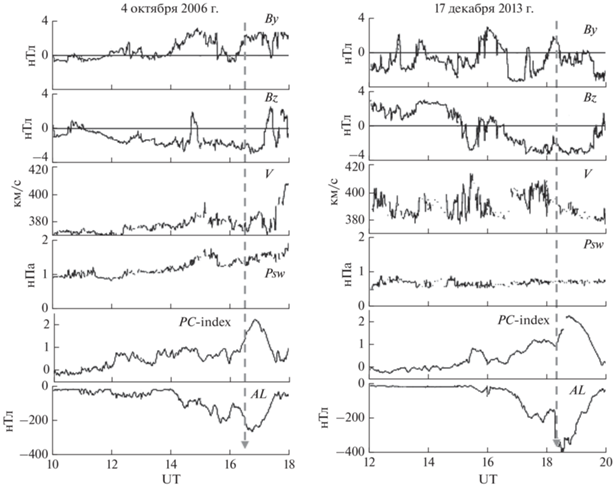
Значения AL-индекса во время первой анализируемой полярной суббури (4 октября 2006 г.) были почти вдвое меньше, чем во время второй (17 декабря 2013 г), в то же время первая полярная суббуря была почти вдвое интенсивнее (порядка 600 нТл), чем вторая (порядка 300 нТл). Высокоширотные станции, на которых наблюдались полярные суббури не входят в набор станций, по данным наблюдения на которых вычисляется AL-индекс. Основной вклад в величину AL-индекса в 18–20 UT вносят наблюдения на российских авроральных станциях Тикси, Диксон и Челюскин, которые в это время находятся в послеполуночном секторе Земли. Анализ магнитограмм на этих станциях показал, что в обоих случаях в Тикси регистрировалась суббуря с амплитудой около 200 нТл, а 17 декабря 2013 г. наиболее интенсивная суббуря (почти до 400 нТл) наблюдалась на станции Диксон (эти магнитограммы здесь не приводятся, их можно найти на сайте сети SuperMAG (https://supermag.jhuapl.edu/). Это и привело к повышенным значениям AL-индекса во втором случае. Можно также сделать вывод, что амплитуда полярной суббури в вечернем секторе не зависит от амплитуды суббури, наблюдаемой в это время в послеполуночном (утреннем) секторе.
Заметим, что начало генерации полярных суббурь как и “классических” суббурь, согласно ряду исследователей, в том числе и Akasofu [2017], связывается с процессами внутри замкнутой магнитосферы (а не в ее хвосте), и происходит, по-видимому, внутри плазменного кольца, окружающего Землю как внешней части кольцевого тока, как это рассмотрено в работах [Antonova et al., 2015, 2016]. В магнито-спокойное время в этой области магнитосферы усиливаются продольные токи за счет азимутального плазменного давления [Antonova et al., 2023]. В настоящее время активно обсуждается роль турбулентности в этом процессе.
Мы установили, что общие закономерности развития полярных суббурь соответствуют типичным характеристикам “классических” суббурь, а именно, формирование токового клина суббури (положительных магнитных бухт в более низких широтах), скачкообразное перемещение активизаций к полюсу после начала суббури, генерация геомагнитных пульсаций Pi2.
Известно, что начало (onset) “классической” суббури определяется как внезапное уярчение самой экваториальной спокойной авроральной дуги, т.е. вблизи экваториальной границы аврорального овала. Поскольку полярные суббури наблюдаются на сжатом овале, то и неудивительно, что экваториальная граница овала находится в более высоких широтах, чем в типичных условиях. Значит, источник начала возбуждения полярных суббурь находится в магнитосфере на более удаленных L-оболочках в области более слабого магнитного поля, где, вероятно, менее жесткие критерии к развитию соответствующей неустойчивости, поэтому полярные суббури наблюдаются в слабо возмущенных геомагнитных условиях и при низкой скорости солнечного ветра.
3. ВЫВОДЫ
Мы установили, что общие закономерности развития полярных суббурь соответствуют типичным характеристикам “классических” суббурь, а именно, (1) формирование токового клина суббури (положительных магнитных бухт в более низких широтах); (2) скачкообразное перемещение активизаций к полюсу после начала суббури; (3) генерация геомагнитных пульсаций Pi2; (4) возрастание РС-индекса полярной шапки перед началом суббури.
В то же время установлено, что имеют место определенные отличия полярных суббурь от “классических” суббурь, а именно, (1) развитие отрицательных магнитных бухт в области сжатого аврорального овала, т.е. на широтах выше ~70° MLAT; (2) максимум появления в более ранние предполуночные часы местного геомагнитного времени; (3) генерация только при низкой скорости солнечного ветра; (4) развитие в магнито-спокойных или слабо возмущенных геомагнитных условиях.
Таким образом, можно сделать вывод, что полярные суббури представляют собой специфический тип “классических” суббурь и являются характерным возмущением, развивающимся в условиях сжатого аврорального овала, т.е. на более дальних L-оболочках по сравнению с “классическими” суббурями.
Список литературы
– Дмитриева Н.П., Сергеев В.А. Появление авроральной электроструи на широтах полярной шапки: характеристики явления и возможность его использования для диагностики крупномасштабных высокоскоростных потоков солнечного ветра // Магнитосферные исследования. № 3. С. 58–66. 1984.
– Дэспирак И.В., Любчич А.А., Бирнат Х.К., Яхнин А.Г. Полярная экспансия суббуревого западного электроджета в зависимости от параметров солнечного ветра и межпланетного магнитного поля // Геомагнетизм и аэрономия. Т. 48. № 3. С. 297–305. 2008.
– Дэспирак И.В., Любчич А.А., Клейменова Н.Г. “Полярные” и “высокоширотные” суббури и условия в солнечном ветре // Геомагнетизм и аэрономия. Т. 54. № 5. С. 619–626. 2014. https://doi.org/10.1134/S0016793214050041
– Дэспирак И.В., Любчич А.А., Клейменова Н.Г. Суперсуббури и условия в солнечном ветре // Геомагнетизм и аэрономия. Т. 59. № 2. С. 183–190. 2019. https://doi.org/10.1134/S001679401902007X
– Дэспирак И.B., Клейменова Н.Г., Любчич А.А, Малышева Л.М., Громова Л.И., Ролдугин А.В., Козелов Б.В. Полярные магнитные суббури и сияния на Шпицбергене: событие 17 декабря 2012// Изв. РАН. Сер. Физ. Т. 86. № 3. С. 340–348. 2022. https://doi.org/10.31857/S0367676522030097
– Зверев В.А., Логинов Г.А., Пудовкин М.И., Распопов О.М. О поведении пульсаций геомагнитного поля в период, предшествующий полярным магнитным возмущениям // Геомагнитные исследования. № 11. С. 37–44. 1969.
– Клейменова Н.Г., Антонова Е.Е., Козырева О.В., Малышева Л.М., Корнилова Т.А., Корнилов И.А. Волновая структура магнитных суббурь в полярных широтах // Геомагнетизм и аэрономия. Т. 52. № 6. С. 785–793. 2012. https://doi.org/10.1134/S0016793212060059
– Пудовкин М.И., Распопов О.М., Клейменова Н.Г. Возмущения электромагнитного поля Земли. Ч. 2. Короткопериодные колебания геомагнитного поля. Л.: ЛГУ, 1976. 271 с.
– Сафаргалеев В.В., Митрофанов В.М., Козловский А.Е. Комплексный анализ полярных суббурь на основе магнитных, оптических и радарных наблюдений на Шпицбергене // Геомагнетизм и аэрономия. Т. 58. № 4. С. 793–808. 2018 https://doi.org/10.1134/S0016793218040151
– Сергеев В.А., Яхнин А.Г., Дмитриева Н.П. Суббури в полярной шапке – эффект высокоскоростных потоков солнечного ветра // Геомагнетизм и аэрономия. Т. 19. № 6. С. 1121–1122. 1979.
– Фельдштейн Я.И. Некоторые вопросы морфологии полярных сияний и магнитных возмущений в высоких широтах // Геомагнетизм и аэрономия. Т. 3. № 2. С. 227–239. 1963.
– Akasofu S.-I. The development of the auroral substorm // Planet. Space Sci. V. 12(4). P. 273–282. 1964. https://doi.org/10.1016/0032-0633(64)90151-5
– Akasofu S.-L., Perreault P.D., Yasuhara F., Meng C.-I. Auroral substorms and the interplanetary magnetic field. J. Geophys. Res. V. 78(31). P. 7490–7508. 1973. https://doi.org/10.1029/JA078i031p07490
– Akasofu S.-I. Where is the magnetic energy for the expansion phase of auroral substorms accumulated? 2. The main body, not the magnetotail // J. Geophys. Res.: Space Physics. V. 122. P. 8479–8487. 2017. https://doi.org/10.1002/2016JA023074
– Anderson B.J., Takahashi K., Kamei T., Waters C.L., Toth B.A. Birkeland current system key parameters derived from Iridium observations: method and initial validation results // J. Geophys. Res. V. 107. P. 1079. 2002. https://doi.org/10.1029/2001JA000080
– Antonova E.E., Vorobjev V.G., Kirpichev I.P., Yagodkina O.I., Stepanova M.V. Problems with mapping the auroral oval and magnetospheric substorms // Earth Planets Space. V. 67. P. 166. 2015. https://doi.org/10.1186/s40623-015-0336-6
– Antonova E.E., Stepanova M., Kirpichev I.P. et al. Structure of magnetospheric current systems and mapping of high latitude magnetospheric regions to the ionosphere // J. Atmos. Sol. Terr. Phys. V. 177. P. 103–114. 2016. https://doi.org/10.1016/j.jastp.2017.10.013
– Antonova E.E., Stepanova M.V., Kirpichev I.P. Main features of magnetospheric dynamics in the conditions of pressure balance // J. Atmos. Sol. Terr. Phys. V. 242. 2023. https://doi.org/10.1016/j.jastp.2022.105994
– Clausen L.B.N., Baker J.B.H., Ruohoniemi J.M., Milan S.E., Anderson B.J. Dynamics of the region 1Birkeland current oval derived from the Active Magnetosphere and Planetary Electrodynamics Response Experiment (AMPERE) // J. Geophys. Res. V. 117. P. A06233. 2012. https://doi.org/10.1029/2012JA017666
– Despirak I.V., Lubchich A.A., Kleimenova N.G. High-latitude substorm dependence on space weather conditions in solar cycle 23 and 24 (SC23 and SC24) // J. Atmos. Sol. Terr. Phys. 2018. V. 177. P. 54–62. https://doi.org/10.1016/j.jastp.2017.09.011
– Feldstein Y.L., Starkov G.V. Dynamics of auroral belt and geomagnetic disturbances // Planet. Space Sci. V. 15. № 2. P. 209–229. 1967. https://doi.org/10.1016/0032-0633(67)90190-0
– Frey H.U., Mende S.B., Angelopoulos V., Donovan E.F. Substorm onset observations by IMAGE-FUV // J. Geophys. Res. V. 109/ P. A10304. 2004. https://doi.org/10.1029/2004JA010607
– Hones E.W., Akasofu Jr. S.-I., Bame S.J., Singer S. Poleward expansion of the auroral oval and associated phenomena in the magnetotail during auroral substorms, 2. // J. Geophys. Res. V. 76. P. 8241–8257. 1971. https://doi.org/10.1029/JA076i034p08241
– Hones E.W. The poleward leap of the auroral electrojet as seen in auroral images // J. Geophys. Res. V. 90. P. 5333–5337. 1985. https://doi.org/10.1029/JA090iA06p05333
– Horning B.L., McPherron R.L., Jackson D.D. Application of linear inverse theory to a line current model of substorm current systems // J. Geophys. Res. V. 9(34). P. 5202–5210. 1974. https://doi.org/10.1029/JA079i034p05202
– Iijima T., Potemra T.A. Large-scale characteristics of field aligned currents associated with substorms // J. Geophys. Res. V. 83(2). P. 599–615. https://doi.org/10.1029/JA083iA02p00599
– Keiling A., Takahashi K. Review of Pi2 models // Space Sci Rev. V. 161. P. 63–148. 2011.
– Kepko L., McPherron R.L., Amm O. et al. Substorm Current Wedge revisited // Space Sci. Rev. V. 190. P. 1–46. 2015. https://doi.org/10.1007/s11214-014-0124-9
– Loomer E.I., Gupta J.C. Some characteristics of high latitude substorms // J. Atmos. Terr. Phys. V. 42. P. 645–652. 1980.
– Lui A.T.Y., Perreault P.D., Akasofu S.-I., Anger C.D. The diffuse aurora // Planet. Space Sci. V. 21(5). P. 857–861. 1973. https://doi.org/10.1016/0032-0633(73)90102-5
– Lui A.T.Y., Akasofu S.-I., Hones E.W., Jr., Bame S.J., McIlwain C.E. Observation of the plasma sheet during a contracted oval substorm in the prolonged quiet period // J. Geophys. Res. V. 81(7). P. 1415–1419. 1976. https://doi.org/10.1029/JA081i007p01415
– McPherron R.L., Russell C.T., Aubry M.P. Satellite studies of magnetospheric substorms on August 15, 1968: 9. Phenomenological model for substorms // J. Geophys. Res. V. 78(16). P. 3131–3149. 1973. https://doi.org/10.1029/JA078i016p03131
– Mende S.B., Frey H.U., Geller S.P., Doolittle J.H. Multi-station observations of auroras: Polar cap substorms // J. Geophys. Res. V. 104(A2). P. 2333–2342. 1999. https://doi.org/10.1029/1998JA900084
– Mende S.B, Heetderks H., Frey H.U. et al. Far ultraviolet imaging from the IMAGE spacecraft.1. System design // Space Sci. Rev. V. 91. P. 243–270. 2000.
– Milan S.E., Boakes P.D., Hubert B. Response of the expanding/contracting polar cap to weak and strong solar wind driving: implications for substorm onset // J. Geophys. Res. V. 113. P. A09215. 2008. https://doi.org/10.1029/2008JA013340
– Milan S.E., Grocott A., Hubert B. A superposed epoch analysis of auroral evolution during substorms: Local time of onset region // J. Geophys. Res. V. 115. A00I04. 2010. https://doi.org/10.1029/2010JA015663
– Newell P.T., Feldstein Y.I., Galperin Y.I., Meng C.-I. Morphology of night-side precipitation // J. Geophys. Res. V. 101. P. 10.737–10.748. 1996. https://doi.org/10.1029/95JA03516
– Nielsen E., Bamber J., Chen Z.-S., Brekke A., Egeland A., Murphree J.S., Venkatesan D., Axford W.I. Substorm expansion into the polar cap // Ann. Geophys. V. 6(5). P. 559–572. 1988.
– Olson J.V. Pi2 pulsations and substorm onsets: A review // J. Geophys. Res. V. 104. P. 17499–17520. 1999.
– Pashin A.B., Glabmeier K.H., Baumjohann W., Raspopov O.M., Yahnin A.G., Opgenoorth H.J., Pellinen R.J. Pi2 magnetic pulsations, auroral breakups, and the substorm current wedge: A case study // J. Geophys. V. 51. P. 223–233. 1982.
– Pytte T., McPherron R.L., Kivelson M.G., Wes H.I. Jr., Hones E.W. Multiple-satellite studies of magnetospheric substorms: Plasma sheet recovery and the poleward leap of auroral zone activity // J. Geophys. Res. V. 83. P. 5256–5268. 1978. https://doi.org/10.1029/JA083iA11p05256
– Saito T., Yumoto K., Koyama Y. Magnetic pulsation Pi2 as a sensitive indicator of magnetospheric substorm // Planet. Space Sci. V. 24. P. 1025–1029. 1976.
– Saito T. Geomagnetic pulsations // Space Sci. Rev. V. 10. P. 319–412. 1969. https://doi.org/10.1007/BF00203620
– Safargaleev V.V., Kozlovsky A.E., Mitrofanov V.M. Polar substorm on 7 December 2015: preonset phenomena and features of auroral breakup // Ann. Geophys. V. 38(4). P. 901–918. 2020. https://doi.org/10.5194/angeo-38-901-2020
– Sergeev V.A. On the longitudinal localization of the substorm active region and its changes during the substorm // Planet. Space Sci. V. 22. P. 1341–1343. 1974.
– Troitskaya V.A., Kleimenova N.G, Micropulsations and VLF-emissions during substorms // Planet. Space Sci. V. 20(9). P. 1499–1519. 1972. https://doi.org/10.1016/0032-0633(72)90053-0
– Troshichev O.A., Kuznetsov B.M., Pudovkin M.I. The current systems of the magnetic substorm growth and explosive phases // Planet. Space Sci. V. 22. P. 1403–1412. 1974.
– Troshichev O., Janzhura A. Relationship between the PC and AL indices during repetitive bay-like magnetic disturbances in the auroral zone // J. Atmos. Sol. Terr. Phys. V. 71. P. 1340–1352. 2009.
– Troshichev O.A., Podorozhkina N.A., Sormakov D.A., Janzhura A.S. PC index as a proxy of the solar wind energy that entered into the magnetosphere: Development of magnetic substorms // J. Geophys. Res.: Space Physics. V. 119. P. 6521–6540. 2014. https://doi.org/10.1002/2014JA019940
Дополнительные материалы отсутствуют.
Инструменты
Геомагнетизм и аэрономия


